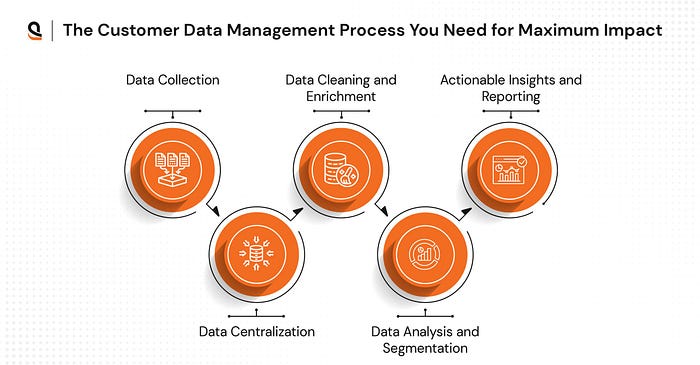Turn Data Into Dollars: Strategic CDM for the Modern Business
 Sarah R. Weiss
Sarah R. Weiss
In today’s digital-first economy, customer data is one of your most valuable business assets — but only if you know how to use it.
From enhancing personalization to ensuring regulatory compliance, effective Customer Data Management (CDM) turns raw information into a measurable business impact.
In this article, we’ll break down:
The 5 core components of a high-performing CDM system
A proven data management process for operational clarity
Strategic use cases that drive revenue and retention
5 Core Components of an Effective CDM System

1. Data Integration — A seamless integration of data from various sources is the bedrock of an effective customer data management system. Whether it’s from your website, mobile apps, CRM, or social media platforms, integrating all these touchpoints into a unified system creates a single source of truth. This is essential for achieving consistency across different departments and ensuring that all teams are working from the same, up-to-date data set.
2. Data Quality — Data is only as valuable as its quality. Ensuring that your data is accurate, clean, and up-to-date is a fundamental aspect of any high-performing customer data management system. Without regular data cleaning and validation, you risk making decisions based on incomplete or incorrect information. Implementing strong data management solutions to maintain data quality ensures that every insight you extract is reliable and actionable.
3. Real-Time Data Access — In today’s fast-paced environment, businesses must have real-time access to customer data to remain competitive. Real-time insights allow companies to make agile decisions, whether it’s responding to customer inquiries or adjusting marketing campaigns based on current behaviors. A high-performing customer data management system should enable businesses to track and respond to changes in customer interactions as they happen, ensuring timely and relevant actions.
4. Advanced Analytics and Reporting — The real value of your customer data management system lies in its ability to generate actionable insights. Advanced data analytics and reporting tools enable businesses to identify trends, track customer behaviors, and predict future actions. These insights empower teams to personalize marketing campaigns, optimize product offerings, and improve customer service. With the right tools, you can harness data to create smarter strategies that drive engagement and profitability.
5. Data Security and Compliance — Data security isn’t just a “nice-to-have” — it’s a must. As data privacy regulations tighten, ensuring your customer data management system complies with laws like GDPR and CCPA is critical. A high-performing system will not only protect sensitive customer information but also build trust with your audience. Robust encryption, secure data storage, and access controls are all part of maintaining compliance and securing customer data in today’s increasingly regulated environment.
The Customer Data Management Process for Real Results

1. Data Collection: The first step in the customer data management process is collecting data from every possible source. Whether it’s transactional data, website visits, social media interactions, or customer support queries, every touchpoint is an opportunity to collect valuable insights.
2. Data Centralization: Once the data is collected, it needs to be centralized in a customer data management system. Centralization ensures that all customer data is stored in one location, making it easy to access and manage. A unified system also reduces the risk of data silos, where information is fragmented across different departments.
3. Data Cleaning and Enrichment: The quality of your data is key to the effectiveness of the entire process. Cleaning involves removing duplicate records, fixing inconsistencies, and ensuring data is up to date. Enrichment may involve supplementing your data with third-party information to create more comprehensive customer profiles.
4. Data Analysis and Segmentation: With clean, centralized data in hand, the next step is to analyze and segment it. This allows businesses to understand different customer behaviors, preferences, and pain points. Segmentation makes it possible to deliver personalized experiences, whether through targeted marketing or customized customer support.
5. Actionable Insights and Reporting: Finally, the goal of customer data management is to produce actionable insights that drive business decisions. By leveraging advanced reporting tools and analytics, businesses can track key performance metrics, uncover trends, and optimize marketing strategies.
Turning Data Into Business Value: Real Use Cases
It’s one thing to manage your customer data, but how do you make it truly work for you? By exploring strategic use cases, we’ll show you how to transform your data into actionable insights that drive business growth. These real-world examples will provide the context you need to understand how customer data management can become a game changer for your business.
1. Personalized Marketing Campaigns — Create Marketing That Feels Personal (Because It Is)
Imagine sending emails or showing ads that speak directly to what your customers care about — like recommending a product they’ve been eyeing, or giving them a discount on something they actually want. That’s what personalized marketing is all about. When you use your customer data to really understand people’s preferences and behavior, your marketing goes from “meh” to “wow, that’s exactly what I needed.”
Subscribe to my newsletter
Read articles from Sarah R. Weiss directly inside your inbox. Subscribe to the newsletter, and don't miss out.
Written by

Sarah R. Weiss
Sarah R. Weiss
I share insights on Software Development, Data Science, and Machine Learning services. Let's explore technology together!